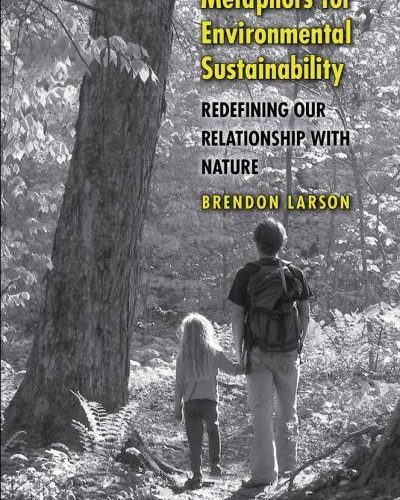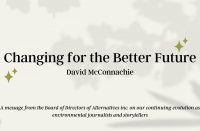“Shifting our behaviour to achieve sustainability depends on society’s ability to reconnect with nature,” writes Brendon Larson. In his first solo-authored book, Metaphors for Environmental Sustainability, Larson, who teaches in the Environment and Resource Studies program at the University of Waterloo and is president of Ontario Nature, encourages his readers to re-examine the language we use about nature. In particular, he wants us to consider how scientific concepts are communicated through metaphor.
“Shifting our behaviour to achieve sustainability depends on society’s ability to reconnect with nature,” writes Brendon Larson. In his first solo-authored book, Metaphors for Environmental Sustainability, Larson, who teaches in the Environment and Resource Studies program at the University of Waterloo and is president of Ontario Nature, encourages his readers to re-examine the language we use about nature. In particular, he wants us to consider how scientific concepts are communicated through metaphor.
Metaphors such as food chain, species richness and ecological integrity are so ingrained in our thinking that we use them without thinking. Larson wants to expose how the various meanings embedded in these metaphors influence how people relate to the natural world. His goal is to have us create new metaphors that motivate people to act sustainably.
The metaphors we use for the Earth, he proposes, influence the way we frame problems and, therefore, affect our actions. Whether Gaia can regulate itself, Mother Earth will take care of us, or Spaceship Earth needs a mechanic, depends on which metaphor is part of your worldview. Larson’s wish is that metaphors can help us recognize our place within nature and our interconnectedness with other species.
The metaphor of competition within the context of ecology is one that Larson says needs rethinking. People often speak of how one plant or animal “out competes” another. He suggests that this metaphor, when applied to nature, indicates that scientists are relying on their own human experience. Competition metaphors lead us to consider nature with a free market, capitalist mentality. We are comfortable with the idea of winners and losers. Exploitation is part of the game. If we were to look at nature as co-operative and harmonious, he argues, it might encourage a more sustainable approach.
Equating continuous growth with progress is another problematic metaphor often applied to the natural world. It’s difficult to put aside the idea of growth, because growth is linked to success. If we remain steady, we are stagnating; if we get smaller, we say we are losing. Larson wonders: Where are we trying to go anyway?
A newer problematic metaphor is to describe DNA as a barcode. In a way, this makes sense since DNA is different for every species, and no two products have the same barcode. Larson is uncomfortable with this metaphor, however, since it creates the impression that species are products that can be bought and sold or, presumably, “discontinued” when they are no longer useful.
Biologists’ use of the militaristic metaphor of an invasive-species “meltdown” is also of concern, given its comparison to a nuclear reactor. The broader problem with these menacing metaphors is that they give the impression that humans are pitted against nature, that humans are outside nature and have to control it.
At times dense with sociological language, the book may be more accessible to social scientists than his stated audience of environmental scientists, everyday citizens and policy makers. Nonetheless, it is worth wading through the jargon to gain Larson’s insights into how language intertwines with our values and profoundly shapes our relationship with nature.
Larson proposes that the public needs to be more involved in selecting metaphors. He goes so far as to suggest that researchers use focus groups to help them find the best metaphor to use in their publications. He imagines a world where everyone is involved in knowledge production, and scientific communication is a two-way endeavour that brings clarity and understanding. Opening the lines of communication, says Larson, will “foster the human interactions that are so essential to sustainability.”
He challenges scientists to think through the implications and multiple meanings of the metaphors they use, and to realize that scientific knowledge is only part of the story. The other is communication, and effective communication involves imagining how others may interpret metaphors within their context.
The power of metaphors is such that once they enter our collective culture, we use them almost unconsciously, which makes them very difficult to unseat. Therefore, says Larson, “we must place our metaphors with great care because they tend to reinforce pre-existent ways of thinking.”
What we need, Larson suggests, are metaphors that emphasize interconnectedness rather than separation between nature and culture. We need metaphors that are hopeful, optimistic and inclusive. Shifting our metaphors in favour of the environment “will shake the very foundations of how we usually think about science” and provide “a vista of possibility for creating a more sustainable future.”
Metaphors for Environmental Sustainability, Brendon Larson, New Haven, Connecticut: Yale University Press, 2011. 320 pages
Subscribe now to get more book reviews in your mailbox!












